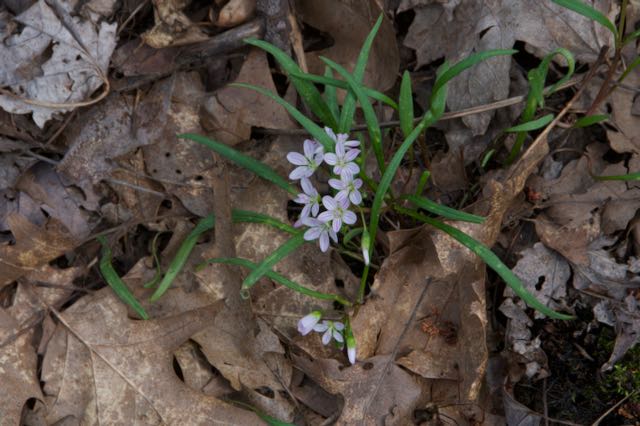Virginia springbeauty

Claytonia virginica
Description:
Morphology of Virginia Springbeauty (Claytonia virginica):
- Growth Form:
- A small, perennial, herbaceous plant with delicate flowers.
- It grows from a small, underground tuber (corm), giving it a bulbous-like structure.
- Leaves:
- Leaves are linear to lance-shaped, about 3 to 15 cm long and 2-8 mm wide.
- Basal leaves are few, while others grow along the slender stem.
- Flowers:
- Flowers are star-shaped and typically 1–2 cm in diameter.
- Each flower has five white or pale pink petals, often marked with darker pink or purple veins.
- The plant produces a loose cluster of 2–10 flowers.
- Flowers open during sunny conditions and close at night or in cloudy weather.
- Blooming period: Early spring, often from March to May.
- Fruit:
- After pollination, it forms a small, rounded capsule with tiny black seeds.
- Stem:
- A slender, green, and often reddish stem that grows between 10–30 cm tall.
Ecology of Virginia Springbeauty:
- Habitat:
- Found in moist, deciduous woodlands, meadows, forest edges, and floodplains.
- Prefers well-drained, rich soils with partial sunlight or dappled shade.
- Pollinators and Reproduction:
- Primarily pollinated by native bees, including Andrena bees (miner bees).
- Flowers provide nectar and pollen, attracting early-season pollinators.
- Cross-pollination is common, but the plant is also capable of self-pollination if pollinators are scarce.
- Life Cycle and Phenology:
- An ephemeral species, meaning it completes its life cycle quickly in early spring before trees fully leaf out.
- After flowering and seed dispersal, the leaves and stems die back, with the plant remaining dormant underground until the following year.
- Dispersal:
- Seeds may be dispersed by ants (a process called myrmecochory), attracted to the nutrient-rich appendages on the seeds.
- The underground corm allows the plant to survive harsh summer and winter conditions.
- Conservation:
- Widespread and not considered threatened, though habitat loss could reduce local populations.
Virginia springbeauty is a beautiful indicator of early spring and a key part of forest ecosystems, supporting early pollinators. Its ephemeral nature reflects its adaptation to take advantage of the short window of light in early spring.
Details:
Virginia springbeauty
[wi_plants_standard_vw filter="attr::emd_usda_symbol::is:: CLVI3;"]
[wip_eco_standard_vw filter="attr::emd_usda_symbol::is:: CLVI3;"]
[wip_legal_standard_vw filter="attr::emd_usda_symbol::is:: CLVI3;"]
[wip_morph_standard_vw filter="attr::emd_usda_symbol::is:: CLVI3;"]
[wip_require_standard_vw filter="attr::emd_usda_symbol::is:: CLVI3;"]
[wip_repro_standard_vw filter="attr::emd_usda_symbol::is:: CLVI3;"]
[wip_use_standard_vw filter="attr::emd_usda_symbol::is:: CLVI3;"]
References:
- Integrated Taxonomic Information System – Claytonia virginica
- USDA Database – Claytonia virginica
- WisFlora Database – Claytonia virginica
